Bhagavad Gita Most Popular (Powerful) Slokas with meaning (Sanskrit, Kannada, English) | What is the Most Famous Line (Mantra, Quote) from Bhagavad Gita? | Top Slokas (Important, Famous, Easy) of Bhagavad Gita
Namaste friends, how are you doing today? Welcome to #BhagavanBhakthi website / blog.
Bhagavan Lord Sri Vishnu (Krishna, Rama, Trivikrama, Narasimha, Vamana, Vasudeva, Mukunda) and Goddess Lakshmi (Rukmini, Satyabhama, Sita, Kamala, Maya) blessings to you and your family!
In this website / blog, you will always learn about #Hinduism #Sanskrit language.
Also subscribe to my YouTube channel from this link #BhagavanBhakthi to view videos about #Hinduism #Sanskrit language.
Just before going to “Bhagavad Gita Most Popular (Powerful) Slokas with meaning (Sanskrit, Kannada, English) | What is the Most Famous Line (Mantra, Quote) from Bhagavad Gita? | Top Slokas (Important, Famous, Easy) of Bhagavad Gita“, let us have a brief some brief information.
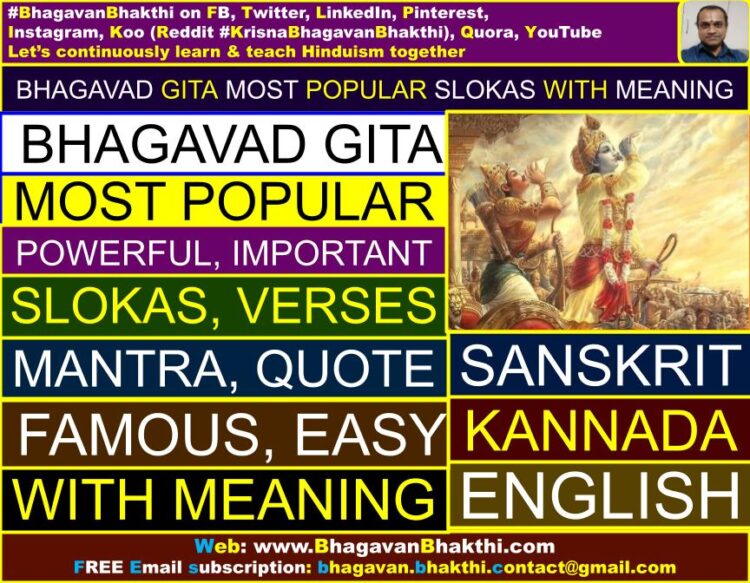
Bhagavad Gita is one of the most divine granthas (Hindu divine books) not only for Hindus, but for the whole world and to the whole mankind.
Just before the start of the Mahabharata (Kurukshetra) war – Bhagavan Sri Krishna in the form of Gita (divine song) preaches this to his friend and great devotee Arjuna.
But, we should always remember that Bhagavan Sri Krishna not just preached the great Bhagavad Gita only to Arjuna. No, it’s not like that.
Bhagavan Sri Krishna has preached the great Bhagavad Gita to all – and especially to the Kali Yuga people as we lack the correct knowledge of Sanatana Dharma. Thus we should keep this in our mind that, Bhagavad Gita is for the wellbeing of all the living beings on earth.
Bhagavad Gita = Bhagavan’s + Gita = Bhagavan Sri Krishna preaches in the form of Gita (divine song) and thus the name Bhagavad Gita.
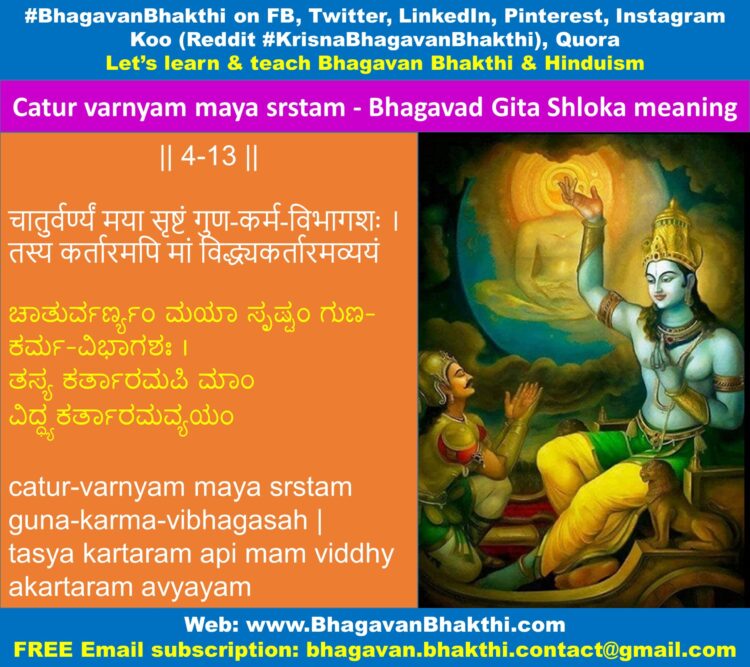
Now let us come to the most popular shlokas of Bhagavad Gita:
1. चातुर्वर्ण्यं मया सृष्टं गुण-कर्म-विभागशः । तस्य कर्तारमपि मां विद्ध्यकर्तारमव्ययं || 4-13 ||
ಚಾತುರ್ವರ್ಣ್ಯಂ ಮಯಾ ಸೃಷ್ಟಂ ಗುಣ-ಕರ್ಮ-ವಿಭಾಗಶಃ । ತಸ್ಯ ಕರ್ತಾರಮಪಿ ಮಾಂ ವಿದ್ಧ್ಯಕರ್ತಾರಮವ್ಯಯಂ || 4-13 ||
cāturvarṇyaṁ mayā sr̥ṣṭaṁ guṇa-karma-vibhāgaśaḥ। tasya kartāramapi māṁ vid’dhyakartāramavyayaṁ || 4-13 ||
Meaning: chatur-varnyam = The four varnas / divisions of human society; mayaa = Done by Me (Sri Krishna); srstam = Created; guna = quality; karma = Karma; vibhagasah = In the form of division;
tasya = Of that; kartaram = The father; api = although; mam = Me (Sri Krishna); viddhi = you may know; akartaram = As the non-doer; avyayam = Being unalterable.
Translation: I (Sri Krishna) have created four Varnas, that is, Brahmana, Kshatriya, Vaishya and Shudra based on the Karma and deeds of Jeevas (living beings).
And, although I am the creator of these four varnas, you should always remember that I am (Sri Krishna) yet the non-doer and being unalterable.
A great saint of Sri Madhwa (Dvaita) Sampradaya, Sri Raghavendra Swamy – has given an extensive explanation for this shloka with the help of Sri Madhwacharya Ji’s commentary.
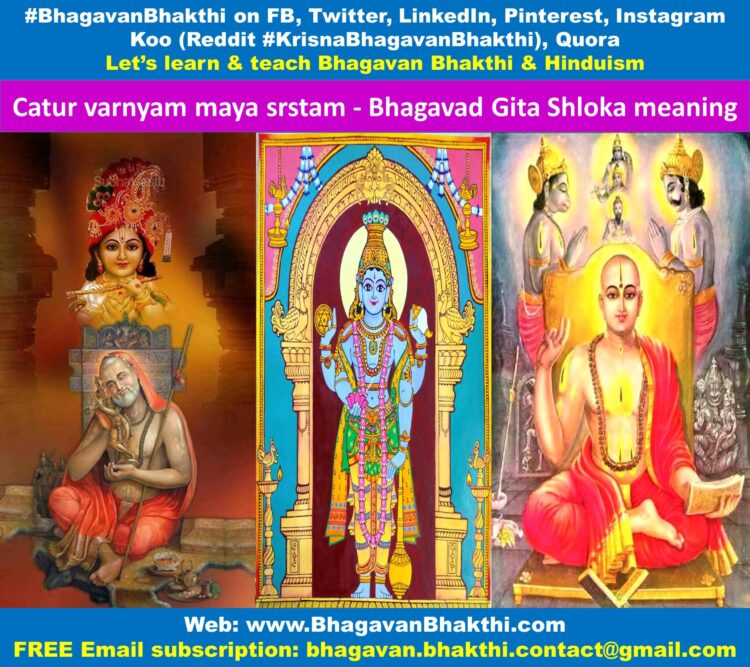
Left: Sri Raghavendra Swamy; Middle: Sri Krishna; Right: Sri Madhwacharya Ji.
This Varna system explained is not limited to only India, but is applicable to the entire humanity. On the outward way it may look like Bhagavan Sri Krishna has created these four varnas, that is, Brahmana, Kshatriya, Vaishya, Shudra.
But Sri Madhwacharya Ji says this classification is not based purely on the body, but is based on aatma / soul. Each aatma / soul has very unique nature of its own.
This means, every aatma / soul is different from each. My aatma / soul is different from your aatma / soul. Many of us know that aatmas / souls have been widely divided into three, that is – Satvika, Rajasa and Tamasa.
Satvikas include all the Devatas / Demigods. Tamasas include the Asuras and lowest level of humans. Rajasas has again divided into three divisions, that is, Rajasa-Satvika, Rajasa-Rajasa, Rajasa-Tamasa.
And again amidst these, Rajasa-Satvika group is divided into chaturvarnya i.e, – Brahmana, Kshatriya, Vaishya and Shudra in Bhagavad gita.
If an aatma / soul (with the combination of Rajasa and Satvika) has greater (too high) ‘Satvika guna’ than ‘Rajasa Guna’, then he will be called as a Brahmana.
If ‘Satva Guna’ is a little more than ‘Rajasa Guna’, than he will be called as a Kshatriya. If ‘Satva Guna’ and ‘Rajo Guna’ are equal in quantity, then he will be called as a Vaishya.
If ‘Rajo Guna’ is higher than ‘Satva Guna’, then he will be called as a Shudra. This is the correct meaning of Chatur Varna as per Hinduism / Sanatana Dharma.
2. परित्राणाय साधूनां विनाशाय च दुष्कृताम् | धर्म-संस्थापनार्थाय संभवामि युगे युगे || 4.8 ||
ಪರಿತ್ರಾಣಾಯ ಸಾಧೂನಾಂ ವಿನಾಶಾಯ ಚ ದುಷ್ಕೃತಾಂ | ಧರ್ಮಸಂಸ್ಥಾಪನಾರ್ಥಾಯ ಸಂಭವಾಮಿ ಯುಗೇ ಯುಗೇ || 4-8 ||
paritrāṇāya sādhūnāṁ vināśāya ca duṣkr̥tāṁ | dharmasansthāpanārthāya sambhavāmi yugē yugē || 4-8 ||
Meaning: paritaranaaya = To protech; sadhunam = All the Bhagavan Sri Vishnu devotees; vinaashaaya = For the annihilation / complete slaying; cha = And; dushkrutaam = All are who are against Dharma (Like Rakshasa, demons etc.);
dharma = Sanatana Dharma; samsthaapana-arthaya = Mainly to re-establish; sambhavaami = I will definitely appear; yuge = Every time and time (now and then); yuge = Every time and time (now and then).
Translation: For the protection of all the Bhagavan Sri Vishnu devotees, for the annihilation / complete slaying of people who are against Sanatana Dharma and to re-establish Sanatana Dharma I (Bhagavan Sri Vishnu) incarnate from time to time (again and again).
Here we should always keep in mind that, Bhagavan Sri Krishna is telling that ‘Yuge Yuge’, this means – from time to time (again and again) and not just every Yuga (Like Satya Yuga, Treta Yuga, Dwapara Yuga and Kali Yuga).
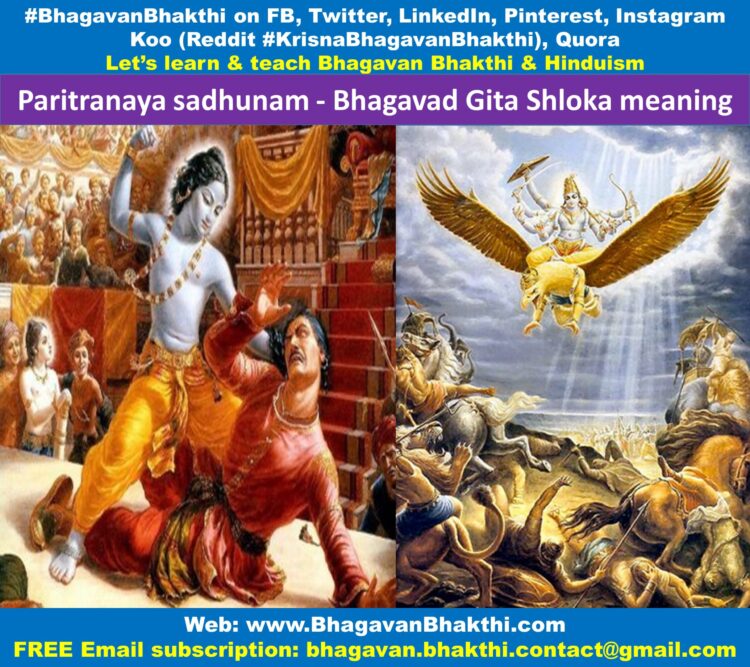
Left: Sri Krishna slaying Kamsa. Right: Bhagavan Sri Vishnu attacking multiple demons.
Also we should note that the words like paritraana instead of traana, vinaashaaya instead of nashaya and samsthaapanaaya instead sthapanaya.
This instructs us all that whenever there is Adharma – Bhagavan Sri Vishnu will completely destroy (and not just destruction) the Adharmi people and will definitely re-establish the Sanatana Dharma completely (and not just partially).
This is the greatness of our greatest Bhagavan Sri Vishnu.
Here Bhagavan Sri Krishna is explaining how he re-establishes Dharma. In reality, Bhagavan Sri Krishna need not have to come personally to establish or to re-establish Sanatana Dharma and to annihilate the Adharma and Adharmis on earth.
Bhagavan Sri Krishna could just reside in each aatma / soul and instigate them to destroy the ill minded people (Adharmis).
If Bhagavan Sri Krishna does it in this simple way, then some fools will not understand the greatness of him (Bhagavan Sri Krishna)
and we will never understand the correct path of Sanatana Dharma and we will loose out the great and divine leader like: Our Bhagavan Purushottama (Another name of Bhagavan Sri Krishna).
Thus, Bhagavan Sri Vishnu / Krishna / Rama comes in the form of humans, lives like humans and shows how to lead a rightful life.
(We should always remember that Bhagavan Sri Vishnu doesn’t has any drawbacks. He is called as ‘aatma kaama’, means he doesn’t need any outer material things to satisfy him. He can get satisfied by himself and doesn’t need anybody’s help or support in anyway).
A great saint from Udupi called Sri Vishweshateertha Ji (of Sri Madhwa – Dvaita sampradaya) has given us a very good example for this:
A mother is capable of walking very fast, but she does not walk very fast as her child might stumble and fall trying to follow her.
Thus, instead she holds the baby’s hand and walks very very slowly like the baby itself and gradually child will learn to walk.
In the same way he will come as Vamana, Rama, Krishna etc and will live among us and show us the path of Sanatana Dharma.
Bhagavan Sri Vishnu doesn’t has any sorrow, weakness, sadness, dejection, misery, suffering, agonize, anguish, pain etc.
Bhagavan Sri Vishnu is called as Sarvottama, Sarveshwara, Parameshwara, Paramaatma, Purushottama, Ishvara, etc, how can he has drawbacks. Only fools can think like this.
3. अनन्याश्चिन्तयन्तो मां ये जना: पर्युपासते | तेषां नित्याभियुक्तानां योगक्षेमं वहाम्यहम् || 9-22 ||
ಅನನ್ಯಾಶ್ಚಿಂತಯಂತೋ ಮಾಂ ಯೇ ಜನಾಃ ಪರ್ಯುಪಾಸತೇ । ತೇಷಾಂ ನಿತ್ಯಾಭಿಯುಕ್ತಾನಾಂ ಯೋಗಕ್ಷೇಮಂ ವಹಾಮ್ಯಹಂ ॥ 9-22 ॥
anan’yāścintayantō māṁ yē janāḥ paryupāsatē। tēṣāṁ nityābhiyuktānāṁ yōgakṣēmaṁ vahāmyahaṁ॥ 9-22॥
Meaning: ananyah = no other than me (Sri Krishna); chintayantah = always thinking of Sri Krishna; mam = only on to Me (Sri Krishna); ye = who all; janah = people;
paryupaasate = worshipping the real and correct devotion; tesham = their; nitya = always (all day) abhiyuktanam = fixed only in devotion; yoga-khsemam = wellbeing; vahami = carry; aham = I am (Sri Krishna).
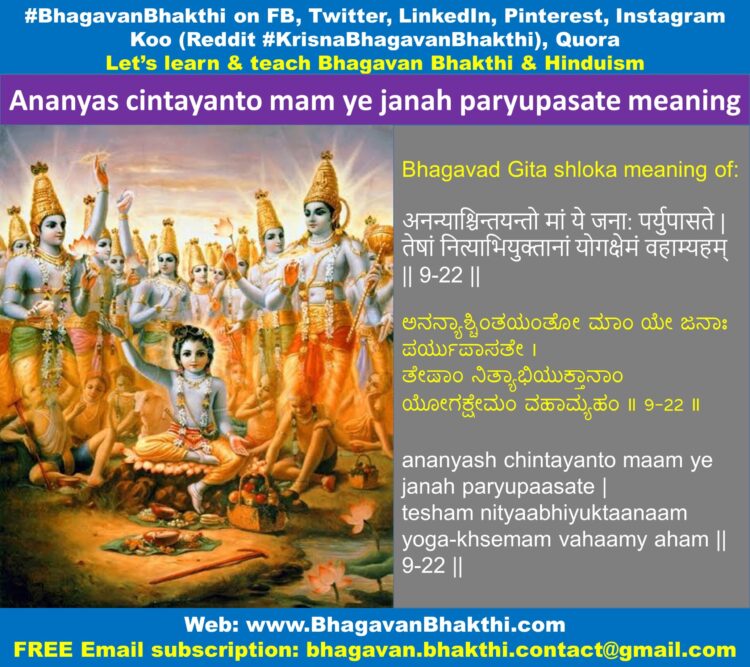
Translation of the shloka: What an affirmation from the Sarvottama / Supreme Bhagavan Sri Krishna to all his real devotees.
Sri Krishna is telling that he will take care of the wellbeing (Yoga-Kheshmam) of all His (Sri Krishna) devotees. But Sri Krishna keeps one condition also.
What is that condition? – All of Sri Krishna’s real devotees should have “Ananya Bhakthi / Chintana” towards HIM through out the life.
But, what is ‘Ananya Bhakti’? – Come on friends, let’s know that pure divinity:
Ananya means ‘no’ anya (no other), that is, single minded devotion (emphasis on Ananya Bhakti), exclusive devotion towards the Sarvottama / Supreme Bhagavan, that is – Sri Krishna / Vishnu / Hari / Rama himself.
For such real devotees, the Sarvottama / Supreme Bhagavan is the one and only reality. He is the one who has saved Pancha Pandavas, Ambarisha, Draupadi Devi, Gajendra, Prahlada, Dhruva, Ajamila etc. etc. etc.
And still continuing that even today and will continue until the ananta kaalam (grand infinite time).
Sri Krishna is giving an affirmation and he is giving it openly proclaiming that – he will definitely take care of their (real devotees) welfare (Yoga-Kshemam), that is:
Sri Krishna is giving the supreme spiritual sense the moksha / mukti (divine liberation) to His all real devotees.
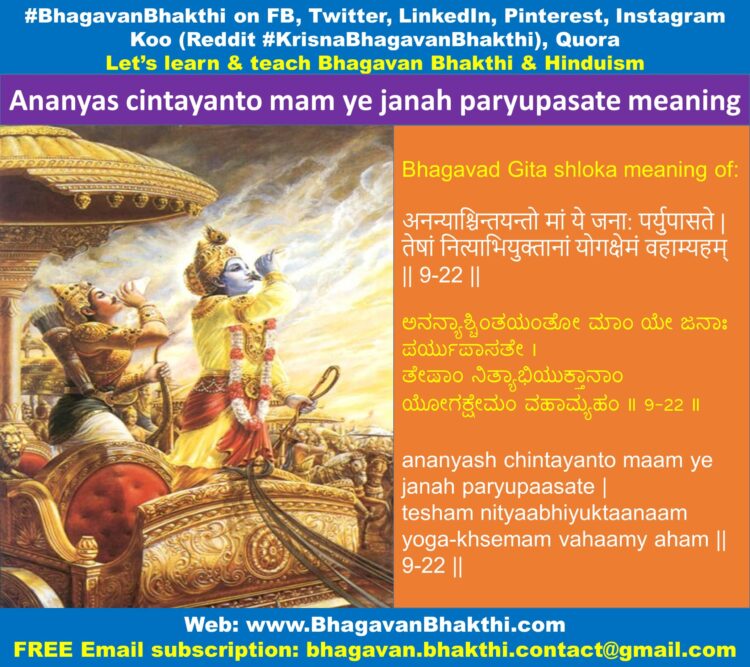
Ananya Bhakti = No Anya Bhakti (Not to depend on others), that is, only Sri Krishna / Vishnu / Rama / Hari Bhakti. We have to learn the Sri Hari Sarvottama through correct Guru like Hanuman / Bhima / Madhwacharya Ji.
But this doesn’t mean we shouldn’t worship other devatas like Sri Maha Lakshmi Devi, Sri Brahma Deva, Sri Sarasvati Devi, Sri Shiva, Sri Tulasi Devi, Sri Parvati Devi, Sri Indra Deva, Sri Surya Deva, Sri Chandra Deva etc.
Yes, we have to worship all the devatas too. But we should always keep in mind that Sri Krishna / Vishnu / Rama / Hari is the Sarvottama / Supreme and all others are his followers.
Whatever Sri Krishna instructs, these Devatas has to follow those instructions. We should worship all these Devatas, as Sri Krishna / Vishnu / Rama / Hari is the ‘antaryaami’ of all these Devatas.
Sri Krishna / Vishnu / Rama / Hari is the ‘antaryaami’ of all. He is present in everyone and is present in everything. We should always keep this in our mind throughout our life.
(This shloka also comes in Sri Vishnu Sahasra Nama’s Phala Shruti.)
4. धृतराष्ट्र उवाच
धर्म क्षेत्रॆ कुरुक्षेत्रे समवेता युयुत्सव: । मामका: पांडवाश्चैव किमकुर्वतु संजय ।। 1-1 ।।
ಧೃತರಾಷ್ಟ್ರ ಉವಾಚ
ಧರ್ಮ ಕ್ಷೇತ್ರೆ ಕುರುಕ್ಷೇತ್ರೇ ಸಮವೇತಾ ಯುಯುತ್ಸವ: | ಮಾಮಕಾ: ಪಾಂಡವಾಶ್ಚೈವ ಕಿಮಕುರ್ವತು ಸಂಜಯ || 1-1 ||
Dhritarastrah uvaca
Dharma kṣētre kurukṣētrē samavētā yuyutsava: | Māmakā: Pāṇḍavāścaiva kimakurvatu san̄jaya || 1-1 ||
King Dhritarastra asks Sanjaya: dharma-ksetre—A place where only “Dharma” is followed; kuru-ksetre—A place called Kurukshetra (Kuru’s place); samavetah—Assembled;
yuyatsavah—desiring to fight; mamakah—my party (my sons); pandavah—the sons of Pandu; ca—and; eva-certainly; kim—what; akurvata—did they do; sanjaya—O Sanjaya.
Just before the start of the divine war of Kurukshetra (Mahabharata war), Dhritarashtra asks Sanjaya:
After having assembled at the holy Kurukshetra, what are my sons and pandu’s sons are doing?
Arjuna was confused whether to fight or not against his Pitamaha Bhishma, Guru Drona, Brothers like Duryodana and others, and also other elder Kauravas in Kurukshetra.
Arjuna decided not to fight and asked suggestion from Bhagavan Sri Krishna. Then Sri Krishna showed Arjuna ‘Vishnuroopa Darshanam’ (divine form of Bhagavan Sri Krishna) and gave a divine explanation of Srimad Bhagavad Gita.
Every moment a confused Arjuna (this means we all) opens the divine Bhagavad Gita to take the advice of Sri Krishna.
And through the divine Bhagavad Gita – Sri Krishna has been explaining and giving solutions to the various problems faced by the confused Arjunas (today’s people) for centuries and will continue to do the same forever…
How many chapters does Bhagavad Gita has: In total 18 chapters.
The different Chapters of Bhagavad Gita are as follows:
Vishadha Yoga | Sankhya Yoga | Karma Yoga | Jnaana Yoga | Karma Vairagya Yoga (Sanyasa Yoga) | Dhyana Yoga | Jnaana Vijnana Yoga | Akshara brahma Yoga | Raja-Vidya-Guhya Yoga |
Vibhuti-Vistara-Yoga | Visvarupa-DarshanaYoga | Bhakti Yoga | Kshetra-Kshetrajna Vibhaga Yoga | Gunatraya-Vibhaga Yoga | Purushottama Yoga | Daivasura-Sampad-Vibhaga Yoga | Shraddhatraya-Vibhaga Yoga | Moksha-Sanyasa Yoga
5.
More information will be added to this on regular basis, please visit after some time to know more information.
To watch videos on #Hinduism #Sanskrit language, SUBSCRIBE to my YouTube channel from this link: #BhagavanBhakthi YouTube channel
To watch the YouTube video about “First shloka of Bhagavad Gita with meaning”, click the below YouTube video link:
To know about Srimad Bhagavad Gita with meaning, please visit this link : Srimad Bhagavad Gita with meaning
To know “Why should we read Bhagavad Gita”, click this link: Why should we read Bhagavad Gita
To know “Srimad Bhagavad Gita full lyrics in Kannada”, please visit this link: Srimad Bhagavad Gita full lyrics in Kannada
To know “Srimad Bhagavad Gita full lyrics in English”, please visit this link: Srimad Bhagavad Gita full lyrics in Sanskrit (Hindi)
To know “Srimad Bhagavad Gita full lyrics in English”, please visit this link: Srimad Bhagavad Gita full lyrics in English
Dear friends, if you need any clarifications about this post, kindly let me know, I will definitely try to answer all of them.
Also your one LIKE, one COMMENT, One Share, one SUBSCRIPTION is highly important.
This will help to know the quality of this content and also it will be helpful to know if any improvements is required for the content.
If you feel this content is useful to you and has helped you to improve your knowledge, kindly share this with your well-wishers.
Because “SHARING MEANS CARING”.
To receive FREE EMAIL SUBSCRIPTION about #BhagavanBhakthi, you can send an email to bhagavan.bhakthi.contact@gmail.com from your email ID.
NAMASTE!
Sri Gurubhyo Namaha
Sri Krishnaayana Namaha
Sri Krishnaarpanamastu
Subscribe / Follow us Share in Social Media
Heya i am for the first time here. I came across this board and I find It truly useful & it helped me out much. I hope to give something back and aid others like you helped me.
I appreciate, cause I found exactly what I was looking for. You have ended my four day long hunt! God Bless you man. Have a nice day. Bye
Thank you for your articles. They are very helpful to me. Can you help me with something?
Your articles are incredibly helpful to me. Thank you! May I request more information?
You’ve been a great help to me. Thank you!
I really enjoyed reading this article
Thank you for posting such a wonderful article. It helped me a lot and I adore the topic.
Thank you for your articles. They are very helpful to me.
Thank you for your post. I really enjoyed reading it, especially because it addressed my issue. It helped me a lot and I hope it will also help others.
Thank you for this insightful post! I loved the way you presented the slokas with their meanings in different languages. It really helps in understanding the depth of the Bhagavad Gita. The explanation of the most famous lines made me reflect on their relevance in today’s world. Looking forward to more such enlightening articles!
Thank you for this insightful compilation of Bhagavad Gita slokas! The meanings provided in Sanskrit, Kannada, and English help deepen the understanding of these powerful verses. It’s fascinating to see how timeless these teachings are and how they can apply to our lives today. I particularly loved the emphasis on the most famous lines; it really captures the essence of the Gita. Keep up the great work!
Thank you for this insightful post! The selection of slokas you highlighted truly captures the essence of the Bhagavad Gita. I especially appreciated the translations and meanings provided, which make it accessible to everyone, regardless of their background. It’s wonderful to see ancient wisdom being shared in such a relatable way. Looking forward to more posts like this!
Thank you for sharing such a beautifully curated list of Bhagavad Gita slokas! The meanings you provided in Sanskrit, Kannada, and English really enhance my understanding and appreciation of these powerful verses. It’s amazing how relevant the teachings remain today. I particularly loved the explanation of the famous quote, “You have the right to perform your prescribed duties, but you are not entitled to the fruits of your actions.” It resonates deeply with me. Keep up the great work!
Thank you for this insightful post! I loved the detailed explanations of the slokas and their meanings in different languages. It’s amazing how the teachings of the Bhagavad Gita remain relevant today. I particularly resonated with the emphasis on selfless action. Can’t wait to explore more of these powerful phrases in my daily life!
This post is a wonderful treasure trove of wisdom! I especially loved the translations and explanations of the slokas. It’s inspiring to see such deep philosophical concepts presented in multiple languages. The emphasis on practical understanding makes the teachings of the Bhagavad Gita accessible to everyone. Thank you for sharing these powerful insights!
Thanks, keep in touch!